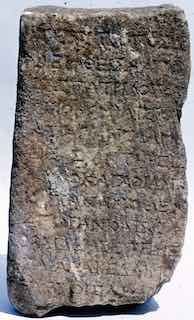Description: Fragment of panel of fine-grained white marble
(w:
0.135 x h:
0.234 x d:
0.076); its top, bottom and right-hand side are broken edges. Stained brown.
Text: Inscribed on face which is encrusted.
The left-hand side might seem to be a cut edge, but in some lines letters are placed so close to the edge as to suggest either
that the panel once extended further. Alternatively, if we have an original edge, it was placed up against another panel on
which the inscribed lines began.
Letters: Lacking.
Date: First to second centuries CE
Findspot:
Cyrene:
Sanctuary of Demeter and Kore: area C13, 1, 3.
Original location: Unknown.
Last recorded location:
Cyrene Museum, Storeroom of the American excavations
(Inv. no. 77-685)
Interpretive
------
[---]ΑΤΕΠΙΤΡΟΠΟΣΝ[---]
[---]ω̣ λειφθεῖσα ἀπὸ [---]
[---]Λ τῆς πατρίδος Ο̣[---]
[---] ὁμονομία Τ̣Ε̣[.]Ο̣Λ̣[---]
5[---]μ̣ατα πάντα ἅμ[α?---]
[---]Ε̣ΙΕ[.]Σ[.]Α̣ΕΤΗΡΕ̣Γ̣[---]
[---]Ε̣ κα̣λοκαγαθίαν κ[---]
[---]Ε̣Κ[.]Ε̣[.]ΑΝΑΝ ὅθεν [---]
[---] ἀγωγὰ̣ν καὶ σω̣φ[ροσύνην ---]
10[---] παιδέας ΕΠΕΜΕ[---]
[---] παρὰ Λακεδαιμο[νίων? ---]
[---]ΥΡΣ̣[.]ΟΙΣ̣Λ̣[.]Ρ̣[---]
------?
Diplomatic
------
[---]ΑΤΕΠΙΤΡΟΠΟΣΝ[---]
[---].ΛΕΙΦΘΕΙΣΑΑΠΟ[---]
[---]ΛΤΗΣΠΑΤΡΙΔΟΣ.[---]
[---]ΟΜΟΝΟΜΙΑ..[·]..[---]
5[---].ΑΤΑΠΑΝΤΑΑΜ[.---]
[---].ΙΕ[·]Σ[·].ΕΤΗΡ..[---]
[---].Κ.ΛΟΚΑΓΑΘΙΑΝΚ[---]
[---].Κ[·].[·]ΑΝΑΝΟΘΕΝ[---]
[---]ΑΓΩΓ.ΝΚΑΙΣ.Φ[.......---]
10[---]ΠΑΙΔΕΑΣΕΠΕΜΕ[---]
[---]ΠΑΡΑΛΑΚΕΔΑΙΜΟ[....---]
[---]ΥΡ.[·]ΟΙ..[·].[---]
------?
1: May contain the word ἐπίτροπος but I am not sure of it. (Reynolds)
9: I once read σοφ[ίαν] but would now propose σωφ[ροσύνην. (Reynolds)
10: May contain the words ἐπ’ ἐμέ but these letters could equally well be part of the verb ἐπιμελέομαι.
12: May in fact be from the final line of the text, since what could be the top of a letter below could also be from a lower moulding.
English translation
Translation source: Reynolds, 2012
...? procurator (or ?guardian)... ...left behind from... ...of the country... ...participation in the same laws... ...all
the ..?.. at once (?)... ...?guard... ...proper behaviour... ...whence... ...way of life and ?temperance... ...of training
of the young... ...from the Lacedaimonians (or Lacedaimon)...
Bibliography: Reynolds, 1978a, 118-9 (phrases only), whence mentioned SEG 1978.1566; Reynolds, 2012, A.34, whence SEG 62.1794.
Text constituted from: Transcription (Reynolds).
Images
 Fig. 1
Fig. 1. Face (Donald White)
 Fig. 2
Fig. 2. Face (Donald White)

